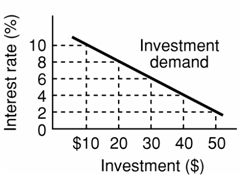 |
| 1 |  | 
If the current interest rate is below the equilibrium rate: |
|  | A) | the money supply exceeds the quantity of money demanded. |
|  | B) | the money supply will increase and the interest rate will rise. |
|  | C) | the money supply will decrease and the interest rate will rise. |
|  | D) | the interest rate will rise and the quantity of money demanded will decrease. |
|
|
 |
| 2 |  | 
A decrease in the money supply will: |
|  | A) | raise interest rates, reducing planned investment and GDP. |
|  | B) | raise interest rates, increasing planned investment and lowering GDP. |
|  | C) | reduce interest rates, increasing planned investment and GDP. |
|  | D) | reduce interest rates, reducing planned investment and GDP. |
|
|
 |
| 3 |  | 
If the Fed buys bonds from the public through its open market operations: |
|  | A) | both the price of bonds and the interest rate received by bond holders will increase. |
|  | B) | both the price of bonds and the interest rate received by bond holders will decrease. |
|  | C) | the price of bonds will decrease and the interest rate received by bond holders will increase. |
|  | D) | the price of bonds will increase and the interest rate received by bond holders will decrease. |
|
|
 |
| 4 |  | 
Refer to the following:
 <a onClick="window.open('/olcweb/cgi/pluginpop.cgi?it=jpg::::/sites/dl/free/0077337727/883761/ch33_q4.jpg','popWin', 'width=NaN,height=NaN,resizable,scrollbars');" href="#"><img valign="absmiddle" height="16" width="16" border="0" src="/olcweb/styles/shared/linkicons/image.gif"> (21.0K)</a> <a onClick="window.open('/olcweb/cgi/pluginpop.cgi?it=jpg::::/sites/dl/free/0077337727/883761/ch33_q4.jpg','popWin', 'width=NaN,height=NaN,resizable,scrollbars');" href="#"><img valign="absmiddle" height="16" width="16" border="0" src="/olcweb/styles/shared/linkicons/image.gif"> (21.0K)</a>
Suppose the interest rate is currently 6% and the Fed determines that investment of $40 is required to reach full employment GDP. To target this outcome, the Fed might: |
|  | A) | sell bonds to the public. |
|  | B) | lower the discount rate. |
|  | C) | raise the reserve requirement. |
|  | D) | auction fewer reserves through the Term Auction Facility. |
|
|
 |
| 5 |  | 
Which of the following will cause the aggregate demand curve to shift to the left? |
|  | A) | a reduction in interest rates. |
|  | B) | an expansionary monetary policy. |
|  | C) | a reduction in the reserve requirement. |
|  | D) | Fed sales of bonds to the public. |
|
|
 |
| 6 |  | 
Two primary assets of the Federal Reserve Banks are: |
|  | A) | securities and Federal Reserve Notes outstanding. |
|  | B) | securities and Treasury deposits. |
|  | C) | Federal Reserve Notes outstanding and reserves of commercial banks. |
|  | D) | securities and loans to commercial banks. |
|
|
 |
| 7 |  | 
Suppose the demand for money falls. In order to maintain interest rates at their previous level, the Fed might: |
|  | A) | sell government securities. |
|  | B) | lower the reserve requirement. |
|  | C) | lower the discount rate. |
|  | D) | sell additional reserves through the Term Auction Facility. |
|
|
 |
| 8 |  | 
Suppose banks are just meeting their reserve requirement of 25% and the Fed sells $30 billion in government securities to commercial banks. The effect of this sale is to: |
|  | A) | increase excess reserves by $30 billion. |
|  | B) | reduce excess reserves by $7.5 billion. |
|  | C) | reduce the potential money supply by $90 billion. |
|  | D) | reduce the potential money supply by $120 billion. |
|
|
 |
| 9 |  | 
If the intent of the Fed is to increase GDP, it should: |
|  | A) | raise the reserve requirement. |
|  | B) | raise the discount rate. |
|  | C) | purchase government securities in the open market. |
|  | D) | ask banks to reduce their amount of loans outstanding. |
|
|
 |
| 10 |  | 
The Taylor Rule suggests that: |
|  | A) | for each 1 percent increase in inflation above its target rate, the Fed should reduce the real Federal funds rate by ½ percentage point. |
|  | B) | for each 1 percent increase of real GDP above potential GDP, the Fed should raise the real Federal funds rate by ½ percentage point. |
|  | C) | for each 1 percent increase in inflation above its target rate, the Fed should reduce the money supply by 2 percentage points. |
|  | D) | for each 1 percent increase of real GDP above potential GDP, the Fed should increase the money supply by 2 percentage points. |
|
|

